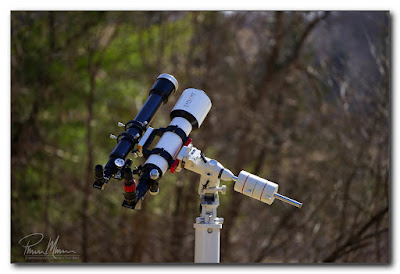My health has been improving this past week, finally, after a lot of physical therapy to build up my strength enough to walk around normally (mostly, anyway). I'm still struggling with breathing problems due to the long-COVID thing but my long-COVID inflammation seems to finally be improving. Since I had some strength and the sun was out, I thought it would be a good day to head outside with some astronomy gear. The sun was penetrating through a lot of haze and high thin clouds today which is better than overcast skies so I decided I should take advantage of this unusually nice weather. I could use all the practice I can get in preparation of the eclipse. Unfortunately, I definitely overdid it today so I'm back to having difficulty walking and even standing. This isn't great weather for solar observing nor imaging but I needed to take advantage of the fair weather with no threats of precipitation.
I was thinking that I'd just take a couple of telescopes outside for an hour or so to run through setting up some astronomy gear just to refresh my memory and see how different combinations of gear would work for the eclipse. What I thought would require just an hour or two took up most of about six hours. I skipped lunch because by lunchtime it was obvious that I would never get anything accomplished if I stopped for lunch. This also meant that I missed my daily two hour nap which is definitely needed for keeping my body stable due to my systemic mastocytosis illness. I'm throwing extra medications at my health this evening in an attempt to stay ahead of any potential issues.
My hour of setting up some gear under the sun turned into an all day affair because it was just one of those days.
I couldn't find various parts I needed. Searching for things ate up most of my time and that really put a huge strain on my spine. Searching for things requires a lot of bending and crouching... two things that do not go well with extensive spinal injuries. In the end, I think I found everything I'll need for the eclipse. Unfortunately, I could use another one or two sunny days before the eclipse to comfortably iron out configurations but I don't think I'll get any more sunny days before eclipse day. I'll have to just work off of what I learned today and create some checklists.
One of the things I wanted to test were my two new solar finder scopes that I made a week or two ago. You can see one of them in the photo below. The sun is an illuminated dot on a bullseye on the back of the solar finder scope. This worked perfectly and allowed me to consistently find the sun quickly and easily, over and over.
I set up one of my manual mounts in the backyard and mounted two telescopes on the one mount (seen below). This dual telescope configuration will allow us to view two different layers of the sun as the moon passes in front of the sun. The white telescope is for viewing the chromosphere of bubbling and spraying hydrogen plasma. The black telescope is for viewing the photosphere of the sun featuring sunspots, faculae and granulation.
Today, for a short while, I was viewing the sun in Hydrogen alpha looking for some interesting features. The sun was almost completely featureless but I found one prominence that was interesting. It was so interesting and rather rare, in fact, that I called Sheila away from her desk to come out to view this feature. This prominence of spraying plasma was shooting up into space and then splitting to the left and the right (really north and south) and then arcing back down to the chromosphere. It was a very interesting feature to watch!
The two oldest grandchildren, Lukey and Kenzie, will be staying with us during the eclipse so I'll set up a few telescopes across the putting green so everyone can safely view the eclipse. I'll have one telescope tasked strictly for imaging and video. Two or three other telescopes will be configured for safely observing the sun throughout the eclipse. We'll also have solar glasses as well as a pinhole projection box for viewing the eclipse.
We have an ideal location assuming the weather cooperates. Our putting green in the backyard is the perfect location (seen below). The sun will be in the position seen in the photo below at the start of the eclipse and then it will move to our right over the course of a few hours. We will have an unobstructed view throughout the eclipse unless clouds get in our way.
This photo, above, is the view from one of the cameras that will be shooting video. This camera will be able to record all of us and the sun as we watch the eclipse. A camera on one of the telescopes will also be recording a close up view of the sun being eclipsed. During totality, I hope to capture nice photos of the corona. Again, the weather will need to cooperate for this to happen.
We'll set up a table and chairs as well as our zero-gravity chaise lounges and snack tables in this area. I have enough battery power to run my astronomy gear for the entire eclipse but I might also run an extension cord back there just in case I find it is necessary.
Things are coming along nicely and we're all looking forward to the eclipse!




Comments
Post a Comment